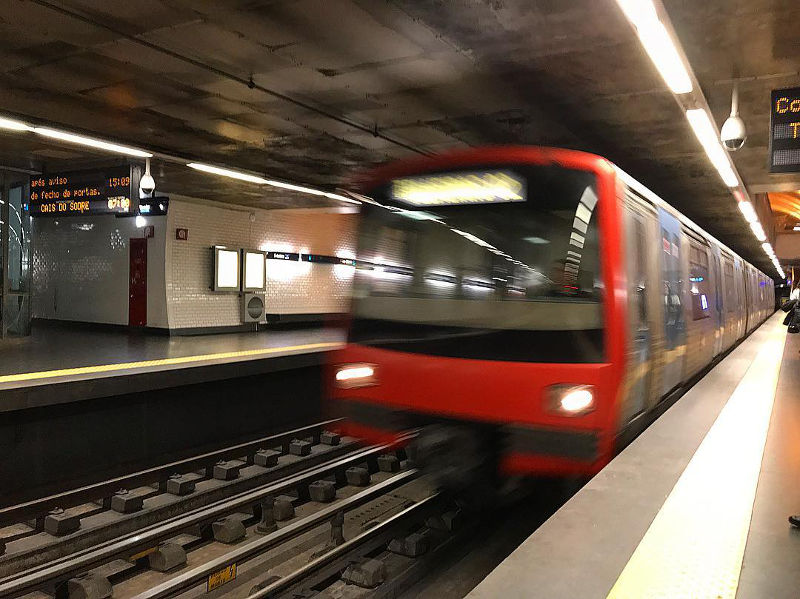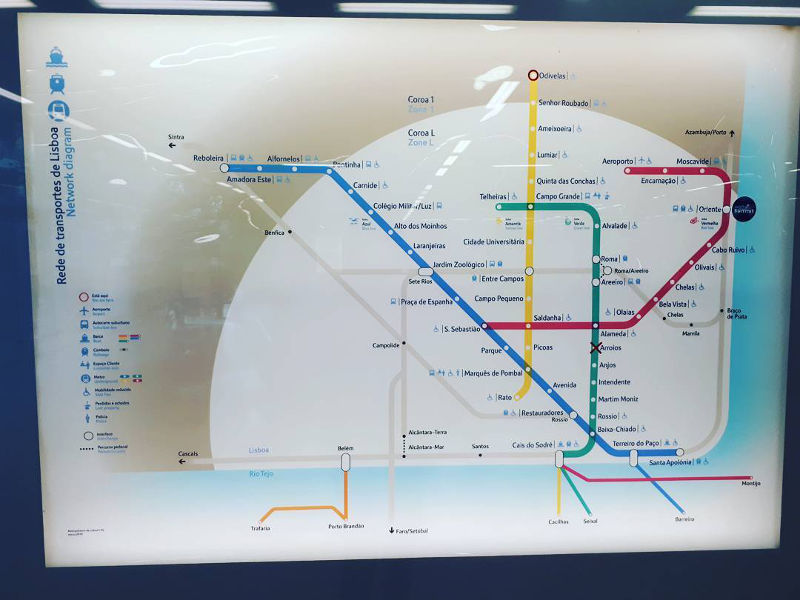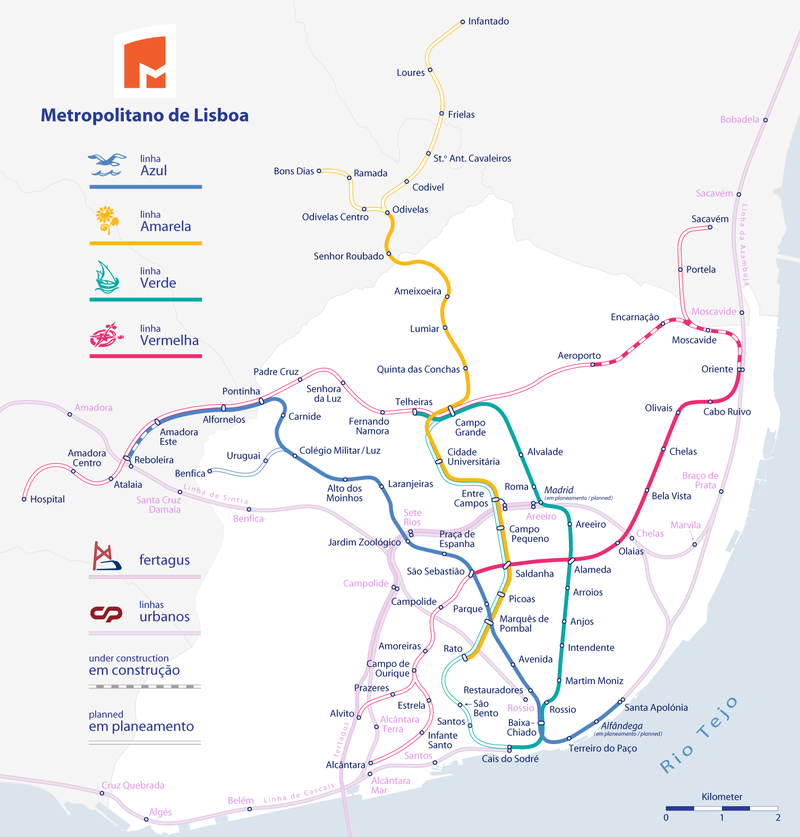The Lisbon metro system, known in Portuguese as the “Metropolitano de Lisboa”, is the fastest way to get from one part of Lisbon to another. It has 4 lines that extend throughout the city. Each line is identifiable by a color, name and logo and each station is identifiable thanks to the system’s logo: a red rectangle with the letter “M” in white and the word “Metro”.
The Lisbon Metro was the first metro in Portugal and is currently operated by a government-owned corporation. The system isn’t completely integrated, but riders can purchase tickets that allow them to travel on the metro and the buses on the Carris network. Overall, the system has 56 stations spread out over 44.2 kilometers (27.5 miles) and provides a quick, comfortable and efficient way to move throughout the city.
Metros in Portugal: Lisboa
Although the Lisbon metro began operating much later, proposals initially picked up in 1888. In the years that followed, several plans for Portugal’s capital to have an efficient transportation system, were presented by various interested parties. However, it wasn’t until after the Second World War that the economy improved sufficiently enough for the construction of a metro system to be considered. In 1948, a society was formed with the purpose of researching whether the project was viable both technically and economically.
Seven years after construction of Portugal’s first metro system began, it opened its first section to the public in December 1959. It was “Y” shaped and included what is now known as the intersection between the blue and yellow lines, lines designated as the “Seagull Line” and the “Sunflower Line” respectively.
The system was first nationalized in 1975 and under the new administration, projects to expand the stations and complete several extensions were carried out. In the years that followed, several stations were constructed to extend the only existing line and it wasn’t until 1995 that the blue line was separated to create the yellow line. In 1988, the blue line was divided again to create the green line, known as the “Caravel Line”. Finally, the red line, known as the “Orient Line”, became the last one to begin operating. It was created to serve the Expo98 area in 1998.
In the years that followed, stations were opened on every line until the current metro system was completed.
 Lisbon Metro
Lisbon Metro
Lines and stations
The Lisbon metro system has 4 lines that all together extend 44.2 kilometers (27.5 miles) and serve 56 stations. Each line has a color, name, and logo. Historically, each line had a picturesque name that was used to identify each line. Today, these names are only used as a secondary reference since the color is the most common way to refer to each one. As memorials to the former names, each line has its own logo. For example, the blue line, previously referred to as the “gaviota line” (“seagull line”) can now be recognized by the blue logo of a seagull flying over the sea.
Blue Line:
This is the only line on the Lisbon Metro that runs completely below ground. The blue line extends from Reboleira to the eastern part of the city, passing through central Lisbon and ending at Santa Apolónia station. Although the current line is not like the previous blue line, part of its route does match the city’s first metro line.
- Line color: Blue
- Name: Linha da Gaivota (Seagull Line)
- Logo: A blue seagull flying over the sea
- Number of stations: 18
- Length: 14 kilometers (8.7 miles)
- Total trip duration: 28 minutes
- Schedule: 6:30 am to 1:00 am
Stations: Reboleira, Amadora Este, Alfornelos, Pontinha, Carnide, Colégio Militar/Luz, Alto dos Moinhos, Laranjeiras, Jardim Zoológico, Praça de Espanha, São Sebastião, Parque, Marquês de Pombal, Avenida, Restauradores, Baixa-Chiado, Terreiro do Paço, Santa Apolónia
Yellow Line:
The 11 kilometers (6.8 miles) of this line run from the north to the south of Lisbon beginning at Odivelas station and extending to the south at Rato station. It was the second line to operate in Lisbon’s metro system.
- Line color: Yellow
- Name: Linha do Girassol (Sunflower Line)
- Logo: A yellow sunflower
- Number of stations: 13
- Length: 11 kilometers (6.8 miles)
- Total trip duration: 20 minutes
- Schedule: 6:30 am to 1:00 am
Stations: Odivelas, Senhor Roubado, Ameixoeira, Lumiar, Quinta das Conchas, Campo Grande, Cidade Universitária, Entre Campos, Campo Pequeño, Saldanha, Picoas, Marquês de Pombal, Rato
Green Line:
The green line’s 13 stations extend from Teheiras station to Cais do Sodré station. This is the shortest line in Lisbon’s metro system.
- Line color: Green
- Name: Linha da Caravela (Caravel Line)
- Logo: A green caravel
- Number of stations: 13
- Length: 9 kilometers (5.6 miles)
- Total trip duration: 18 minutes
- Schedule: 6:30 am to 1:00 am
Stations: Telheiras, Campo Grande, Alvalade, Roma, Areeiro, Alameda, Arroios, Anjos, Intendente, Martim Moniz, Rossio, Baixa-Chiado, Cais do Sodré
Red Line:
Although it is known as the “red line”, this line appears as pink on most maps. This line’s 10 kilometers (6.2 miles) extend from the Airport station, joining Humberto Delgado Airport to São Sebastião station. Its direct extension to the city’s only airport is the easiest and quickest way to travel from the center of the city to the airport.
- Line color: Red/Pink
- Name: Linha do Oriente (Orient Line)
- Logo: A compass rose
- Number of stations: 12
- Length: 10 kilometers (6.2 miles)
- Total trip duration: 20 minutes
- Schedule: 6:30 am to 1:00 am
Stations: São Sebastião, Saldanha, Alameda, Olaias, Bela Vista, Chelas, Olivais, Cabo Ruivo, Oriente, Moscavide, Encarnação, Aeroporto
Schedules and frequency
Lisbon’s four metro lines provide service from 6:30 am to 1:00 am. The first metro leaves from its originating station at 6:30 am and the last ones reach their final stations at 1:30 am. This means it is always possible to take the train later than 1:00 am as long as you have entered the station before that time. The four lines operate daily, including Sundays and holidays.

Although most of the stations on the four lines are open from 6:30 am to 1:00 am daily, (including weekends and holidays), some of the stations have a different schedule than the metro lines:
Blue Line:
- Restauradores: 6:30 am to 9:30 pm
- Avenida: 6:30 am to 9:30 pm. Closed on weekends and holidays.
- Marquês de Pombal: 6:30 am to 9:30 pm. Closed on weekends and holidays.
- Praça de Espanha: 6:30 am to 9:30 pm
Yellow Line:
- Picoas: 6:30 am to 9:30 pm. Closed on weekends and holidays.
- Campo Pequeno: 6:30 am to 9:30 pm. Closed on weekends and holidays.
Green Line:
- Rossio: 6:30 am to 9:30 pm. Closed on weekends and holidays.
- Intendente: 6:30 am to 9:30 pm. Closed on weekends and holidays.
- Anjos: 6:30 am to 9:30 pm. Closed on weekends and holidays.
Frequency:
On weekdays, the metro runs every 5 to 7 minutes from 7:00 am to 9:00 pm. Before and following this period, the metro runs every 8 to 10 minutes. On weekends, it runs about every 8 minutes regardless of the time of day.
Connections
Connections between lines:
Connections between lines are free and do not require any special procedure. As long as you have not gone through the turnstiles and left the station, you can make connections between any line.
Between the blue line and yellow line: You can connect from one line to the other at Marquês de Pombal station.
Between the blue line and green line: You can connect from one line to the other at Baixa-Chiado station
Between the blue line and red line: You can connect from one line to the other at São Sebastião station.
Between the yellow line and green line: You can connect from one line to the other at Campo Grande station.
Between the yellow line and red line: You can connect from one line to the other at Saldanha station.
Between the green line and red line: You can connect from one line to the other at Alameda station.
Connections to other systems:
The Carris/Metro ticket allows unlimited connections between the metro and bus network within 60 minutes following the ticket’s first validation. Some tickets include connections to other systems such as the regional train.
Prices, tickets and passes
Regardless of your preferred ticket type, you can purchase them at any of the ticket offices found at large stations or at any of the machines in the metro’s 55 stations. The machines provide instructions in various languages and accept coins, bills, and credit cards. Purchasing any of the available tickets from a machine requires use of a reloadable Viva Viagem card. The card is €0.50 ($US 0.62), which can be added to the cost of the ticket. It can be obtained during the first ticket purchase at any station and it can be loaded with the tickets you buy.
Tickets:
Carris/Metro ticket: €1.45 ($US 1.79)
This ticket allows unlimited travel between buses and metro within 60 minutes following its first validation. However, do keep in mind that two consecutive metro trips (by means of leaving a station and reentering another one without taking a bus) are prohibited.
Carris/Metro 1-day ticket (24 hours): €6.30 ($US 7.76)
This ticket allows unlimited travel on Carris’ bus network and on the metro for 24 hours following its first validation.
Carris/Metro/Transtejo (Cacilhas) 1-day ticket (24 hours): €9.35 ($US 11.50)
This ticket allows unlimited travel on the Carris bus network, the metro and on the Cacilhas river connection, for 24 hours, following its first validation.
Carris/Metro/CP 1-day ticket (24 hours) €10.40 ($US 12.80)
This ticket allows unlimited travel on Carris buses, the metro, and the CP urban train network for 24 hours following its first validation.
Zapping:
In addition to purchasing and loading tickets on the Viva Viagem card, there is also the option of loading the card with money. The price of each trip is deducted from the card balance according to the costs of each trip and each operator. This card and method, known as “zapping”, can be used on various modes of transportation such as buses, the metro and trains.
Each metro trip costs €1.31 ($US 1.61) when using this method.
Passes:
In addition to single or unlimited day tickets, Lisbon’s metro system offers passes for its regular riders. They can be purchased at ticket offices, in the machines located at each station or on line. They must be charged to a card equal to another ticket type. They don’t work with the Viva Viagem card, but rather with the Lisboa Viva card.
Most passes allow unlimited travel for a month but the travel range and modes of transportation that can be used depend on the ticket purchased. Some allow unlimited travel exclusively on metros and Carris buses while others include some connections to CP trains.
Most available passes include discounts to low income households, (known as Social +). It also offers discounted passes to the elderly, people on pension, retirees and to children. To find more details on the pricing, conditions, and travel range of these tickets, visit the ticket offices at large stations or the metro’s official webpage.
Rules, tips and warnings
- A metro trip begins after passing through the turnstiles to enter the station and ends when leaving the station. Your card must be passed over the reader when entering and when exiting the metro.
- Traveling on metro requires a Viva Viagem card that contains a valid ticket. Always have your card or ticket ready in case you need to show it to the inspector during your trip.
- As long as you don’t go through the turnstiles to exit the station, you can make unlimited connections between lines.
- Lisbon Metro’s official website has an English version in which you can enter your station of origin and destination in order to find out which metro lines you need to take and how long the trip will last. For more information, visit: http://www.metrolisboa.pt/en/travel/plan-a-journey/.
- Children 3 and under always ride for free when accompanied by an adult with a valid ticket.
- Discounts for people over the age of 65 or retirees are only valid for Lisbon residents.
- Not all stations are equipped for people with limited mobility. Before traveling, visit the official website for stations that have elevators.
- Bicycles are always permitted on the metro, provided that there is not a large number of passengers.
- Pets are always permitted when they are in their proper carriers and in no way disturbing other passengers
- Watch over your personal belongings and avoid displaying your valuables on the metro.
- Watch out for thieves during peak hours, especially near tourist attractions.
Notable facts:
- The Lisbon Metro was the first metro system in Portugal.
- Lisbon’s metro stations are known for the works of art that they contain. From the metro’s beginning, the goal was for the stations to be welcoming and to include artistic elements.
- Each line has its own distinct logo. Instead of being named according to its color, each line previously had picturesque names. Currently, only the logos remain, and the names are no longer used.
Future expansions
Some planned projects were completed in recent years such as the extension of the blue line to its current length at Reboleira terminal station in 2016. As a result, there are no current expansion plans being carried out.
Among those that are being realized is the construction project of two new stations that will connect the green line on Cais do Sodré to the yellow line on Rato, creating a circle/ring formed by the two lines. It is expected that this project will be completed by 2021.
Another consideration is the extension of the Green line from Telheiras-Horta to Nova-Pontinha and the extension of the red line from Moscavide to Sacavém and from São Sebastião to Campo de Ourique.
Connection to the airport
The airport in Lisbon, known as Aeroporto da Portela (Portela Airport), Aeropuerto de Lisboa Humberto Delgado (Humberto Delgado Airport) or simply as Aeropuerto de Lisboa (Lisbon Airport), is the city’s only airport. It can be found about 7 kilometers (4.3 miles) from the city’s center
Those wishing to reach the airport using public transportation can take advantage of the Lisbon metro’s red line system which goes directly to the airport. There is no additional cost to travel to the airport using the metro and it is not necessary to purchase a special ticket. Any 1-day ticket or as a basic single ticket with a value of €1.45 ($US 1.79) will take you to the airport.
The trip from the beginning of the red line at São Sebastião station to the airport is around 20 minutes. The three other lines offer connections to the red line so that you can enter the metro from any of these stations, followed by transferring to the red line to reach the airport. The red line operates from 6:30 am to 1:00 am.
Sightseeing via Lisbon Metro
Castelo de São Jorge (São Jorge Castle): This is undoubtedly one of the most visited tourist sites in Lisbon. The São Jorge Castle can be found on a hill with views overlooking the city. All those who visit can walk through the archaeological remains, visit the museum, take guided tours and enjoy the view from the castle walls. The green line’s Rossio station is about a 15-minute walk from the castle but the 737 bus can also be taken from the metro station if one doesn’t wish to walk.
Oceanário de Lisboa (Lisbon Oceanarium): This is one of the best oceanariums in Europe and one of the largest in the world. It is divided to represent four oceans and each one contains hundreds of distinct species. Attracting both adults and children, the oceanarium is a great place for families. The red line’s Cabo Rubio station is about a 15-minute walk from the oceanarium.
Alfama: This is one of the oldest neighborhoods in Lisbon and it is filled with picturesque streets, historical architecture, restaurants and charming churches. The square has a great viewpoint, equal to that of the Largo das Portas do Sol, the oldest port used by the Moors. One can take the blue and green lines from Baixa-Chiado and become immersed within the neighborhood.
Lisbon metro map
- Passengers/Day 488000
- Fares: 0.80
- 24h operation: No
- Air Conditioning: No
- Walk between platforms: Yes
- Driverless trains: No
- Screen Doors Platforms: No
- 1.40 euro
- Lisbon Metro Official Website
Help us
If you consider that the information we provide is wrong, not accurated, outdated, translation contains errors, and you would like to help us to improve the file...you can contact us here.
Feel free to contact us if you dont find the system you're looking for and we'll add it as soon as we can!
Thank you very much!







